High Density RF-DC Plasma Nitriding under Optimized Conditions by Plasma-Diagnosis
Abstract
:Featured Application
Abstract
1. Introduction
2. Experimental Procedure
2.1. RF-DC Plasma Nitriding System
2.2. Plasma Diagnosis by OES
2.3. Materials Characterization
3. Experimental Results and Discussion
3.1. Plasma Diagnosis on N2 + H2 Plasmas by OES
3.2. Effect of Plasma-Processing Parameters on the Active Species
3.3. Effect of Hydrgen Gas on the Detected Species
3.4. Effect of Hydrogen Gas Content on the NH Radicals
3.5. Low Temperature Plasma Nitriding of AISI304 Stainless Steels
4. Conclusions
Author Contributions
Funding
Institutional Review Board Statement
Informed Consent Statement
Acknowledgments
Conflicts of Interest
References
- Bell, T. Surface engineering of austenitic stainless steel. Surf. Eng. 2002, 18, 415–422. [Google Scholar] [CrossRef]
- Dong, H. S-phase surface engineering of Fe-Cr, Co-Cr and Ni-Cr alloys. Int. Mater. Rev. 2011, 55, 65–98. [Google Scholar] [CrossRef]
- Lo, K.H.; Shek, C.H.; Lai, J.K.L. Recent developments in stainless steels. Mater. Sci. Eng. 2009, 65, 39–104. [Google Scholar] [CrossRef]
- Aizawa, T. Low temperature plasma nitriding of austenitic stainless steels. Chapter 3. In Stainless Steels; IntechOpen: London, UK, 2018; Volume 3, pp. 31–50. [Google Scholar]
- Djoko, D.J.; Aizawa, T. Formation of expanded martensite in plasma nitrided AISI420 stainless steel. In Proceedings of the 8th SEATUC Conference, Johor-Balu, Malaysia, 4 March 2014. [Google Scholar]
- Farghali, A.; Aizawa, T. Nitrogen supersaturation process in the AISI420 martensitic stainless steels by low temperature plasma nitriding. ISIJ Int. 2018, 58, 401–407. [Google Scholar] [CrossRef] [Green Version]
- Lu, S.; Zhao, X.; Wang, S.; Li, J.; Wei, W.; Hu, J. Performance enhancement by plasma nitriding at low gas pressure for 304 austenitic stainless steel. Vacuum 2017, 145, 334–339. [Google Scholar] [CrossRef]
- Aizawa, T.; Shiratori, T.; Komatsu, T. Micro-/nano-structuring in stainless steels by metal forming and materials processing. Chapter 5. In Electron Crystallography; IntechOpen: London, UK, 2020; pp. 101–122. [Google Scholar]
- Borgioli, F.; Galvanetto, E.; Bacco, T. Low temperature nitriding of AISI300 and 200 series austenitic stainless steels. Vacuum 2016, 12, 51–60. [Google Scholar] [CrossRef]
- Farghali, A.; Aizawa, T.; Yoshino, T. Microstructure/mechanical characterization of plasma nitrided fine-grain austenitic stainless steels in low temperature. J. Nitrogen 2021, 2, 244–258. [Google Scholar] [CrossRef]
- Tatarova, E.; Dias, F.M.; Gordiets, B.; Ferreira, C.M. Molecular Dissociation in N2-H2 Microwave Discharges. Plasma Sources Sci. Technol. 2005, 14, 19–31. [Google Scholar] [CrossRef]
- Rosadi, I.; Djoko, D.; Sakti, S.P.; Yunata, E.E.; Aizawa, T. Plasma diagnosis on the mixture gas plasma state for nitriding process. In Proceedings of the 12th SEATUC Symposium, Yogyakarta, Indonesia, 3 March 2018; pp. 131–136. [Google Scholar]
- Kim, Y.M.; Kim, J.U.; Han, J.G. Investigation on the Pulsed DC Plasma Nitriding with Optical Emission Spectroscopy. Surf. Coat. Technol. 2002, 151, 227–232. [Google Scholar] [CrossRef]
- Sharma, M.K.; Saikia, B.K.; Bujarbarua, S. Optical Emission Spectroscopy of DC Pulsed Plasmas Used for Steel Nitriding. Surf. Coat. Technol. 2008, 203, 229–233. [Google Scholar] [CrossRef]
- Tamaki, M.; Yoichi, T.; Yamamoto, N. The role of hydrogen in plasma nitriding: Hydrogen behavior in the titanium nitride layer. Plasmas Ions 2000, 3, 33–39. [Google Scholar] [CrossRef]
- Katoh, T.; Aizawa, T.; Yamaguchi, T. Plasma assisted nitriding for micro-texturing onto martensitic stainless steels. In Proceedings of the 7th AWMFT 2014, Taipei, Taiwan, 9–12 November 2014. [Google Scholar]
- Yunata, E.E. Characterization and Application of Hollow Cathode Oxygen Plasma. Ph.D. Thesis, Shibaura Institute of Technology, Tokyo, Japan, 2016. [Google Scholar]
- Czerwiec, T.; Renevier, N.; Michel, H. Low-temperature plasma-assisted nitriding. Surf. Coat. Technol. 2000, 131, 267–277. [Google Scholar] [CrossRef]
- Li, T.; Zhe, S. The quenching effect of hydrogen on the nitrogen in metastable state in atmospheric-pressure N2-H2 microwave plasma Torch. Phys. Plasmas 2014, 21, 67–72. [Google Scholar] [CrossRef]
- Ricard, A.; Oseguera-Pena, J.E.; Falk, L.; Michel, H.; Gantois, M. Active species in microwave post-discharge for steel-surface nitriding. IEEE Trans. Plasma Sci. 1990, 18, 940–944. [Google Scholar] [CrossRef]
- Guo, J.-Y.; Kuo, Y.-K.; Wang, H.-P. A facile nitriding approach for improved impact wear of martensitic cold-work steel using H2/N2 mixture gas in an AC pulsed atmospheric plasma jet. Coatings 2021, 11, 1119. [Google Scholar] [CrossRef]
- Saito, K. Introduction to Ion Nitriding in Hokunetsu. 2018. Available online: http://hokunetsu.com/products/003/ (accessed on 14 February 2022).
- Taktak, S.; Güneş, I.; Ulker, S. Effect of pulse plasma nitriding on tribological properties of AISI 52100 and 440C steels. Int. J. Surf. Sci. Eng. 2014, 8, 39–56. [Google Scholar] [CrossRef]
- Aizawa, T.; Shiratori, T.; Komatsu, T. Integrated manufacturing of fine-grained stainless steels for industry and medicals. Chapter 1. In Engineering Steels and High Entropy-Alloys; IntechOpen: London, UK, 2020; pp. 1–26. [Google Scholar]
- Aizawa, T.; Yoshino, T. Plastic straining for microstructure refinement in stainless steels by low temperature plasma nitriding. In Proceedings of the 12th SEATUC Conference Yag-Yakarta, Jakarta, Indonesia, 12 March 2018; pp. 11–16. [Google Scholar]
- Aizawa, T.; Yoshino, T.; Shiratori, T.; Yoshihara, S.-I. Grain size effect on the nitrogen supersaturation process into AISI316 at 623 K. ISIJ Int. 2019, 59, 1886–1892. [Google Scholar] [CrossRef]
- Aizawa, T.; Yoshihara, A.-I. Inner nitriding behavior and mechanism in stainless steels at 753 K and 623 K. SEATUC J. Sci. Eng. 2019, 1, 13–20. [Google Scholar]
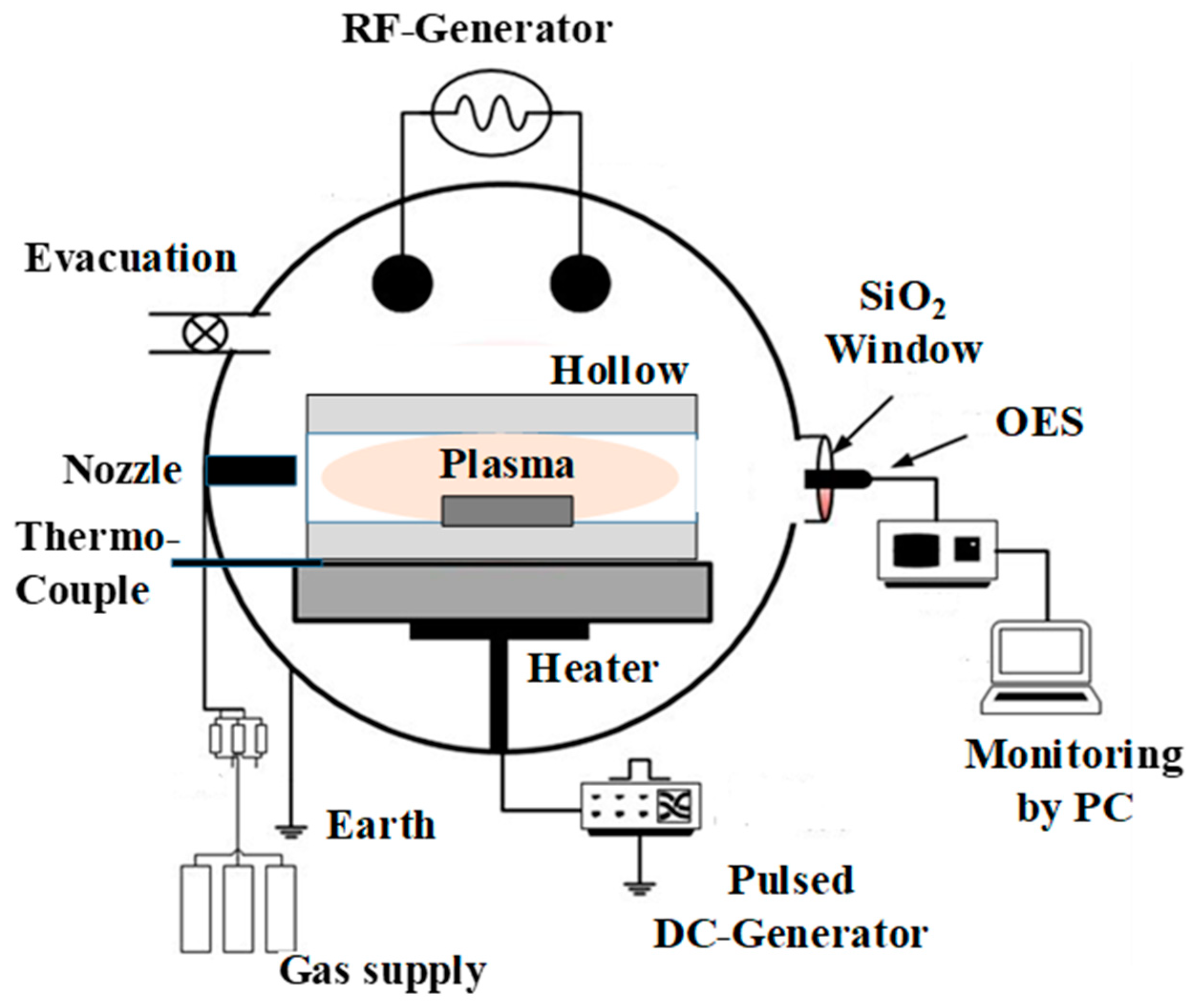
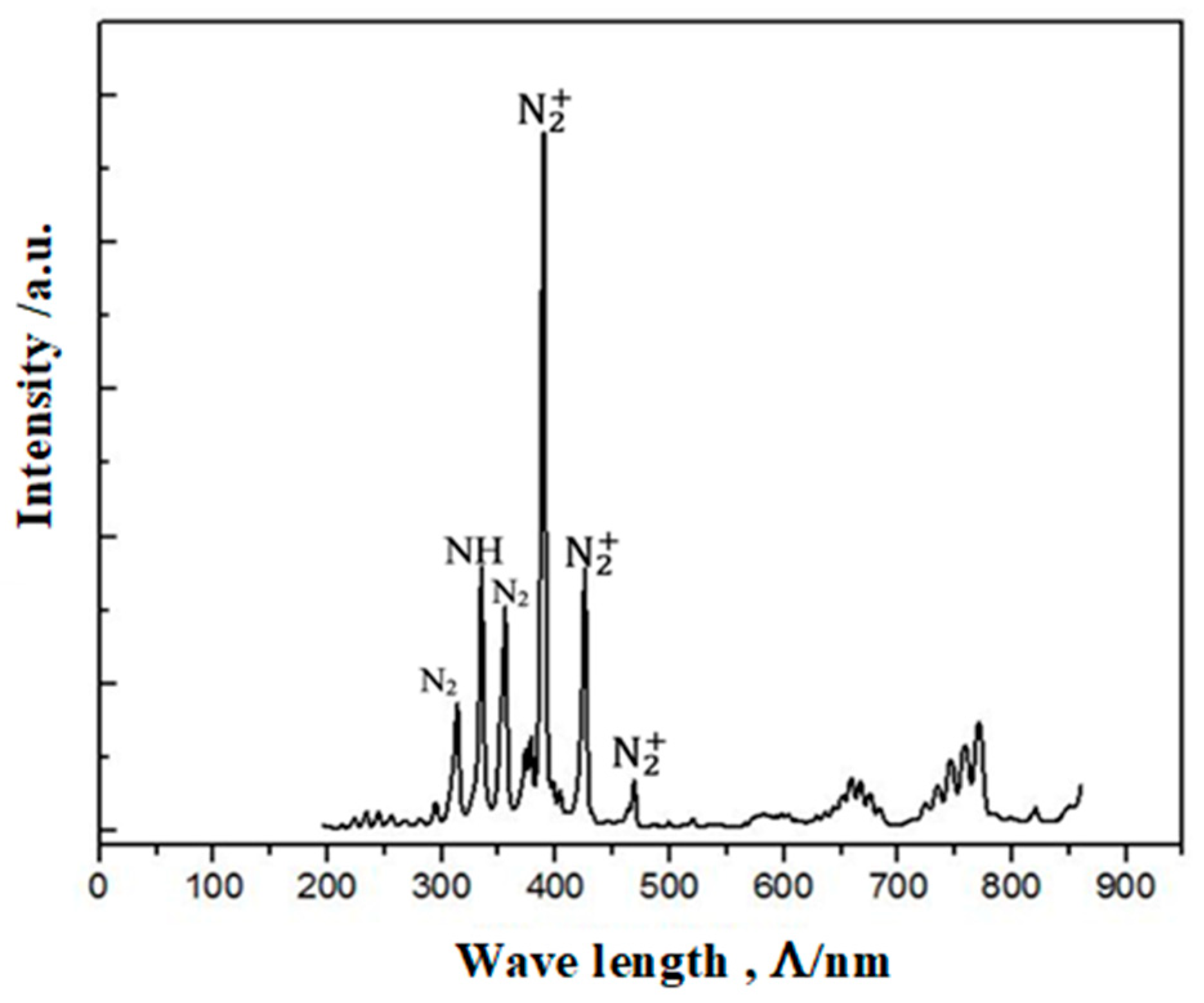
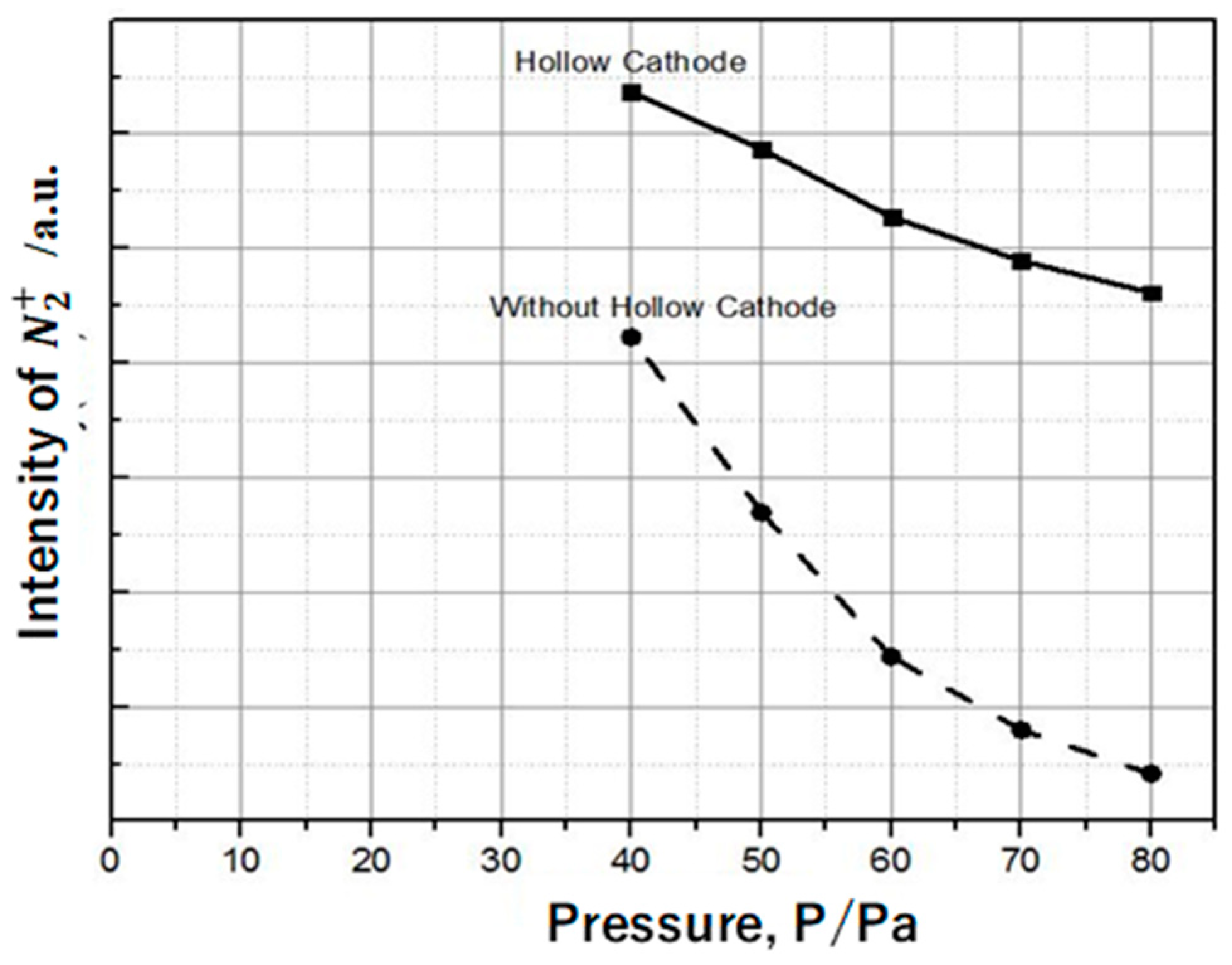
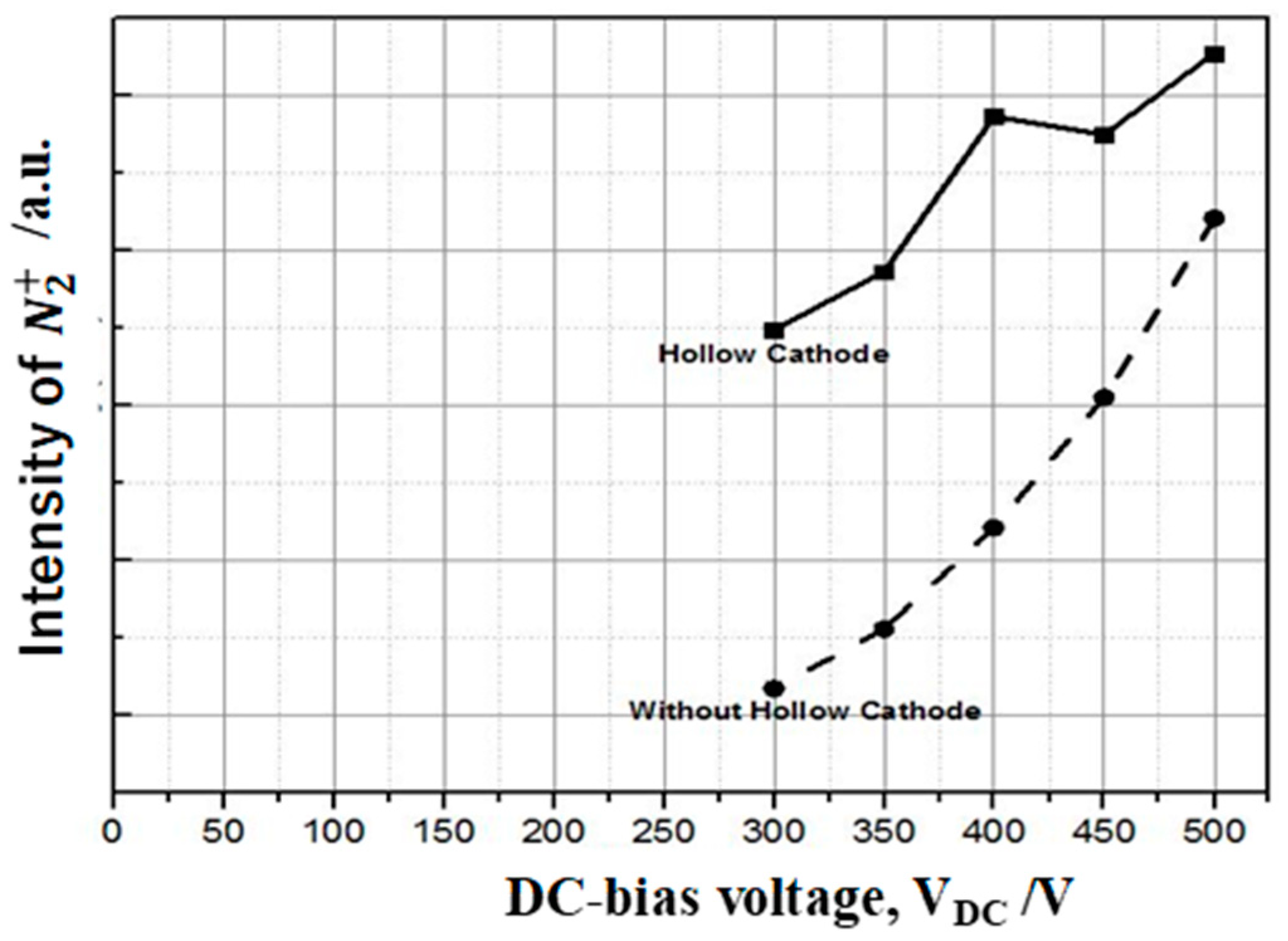
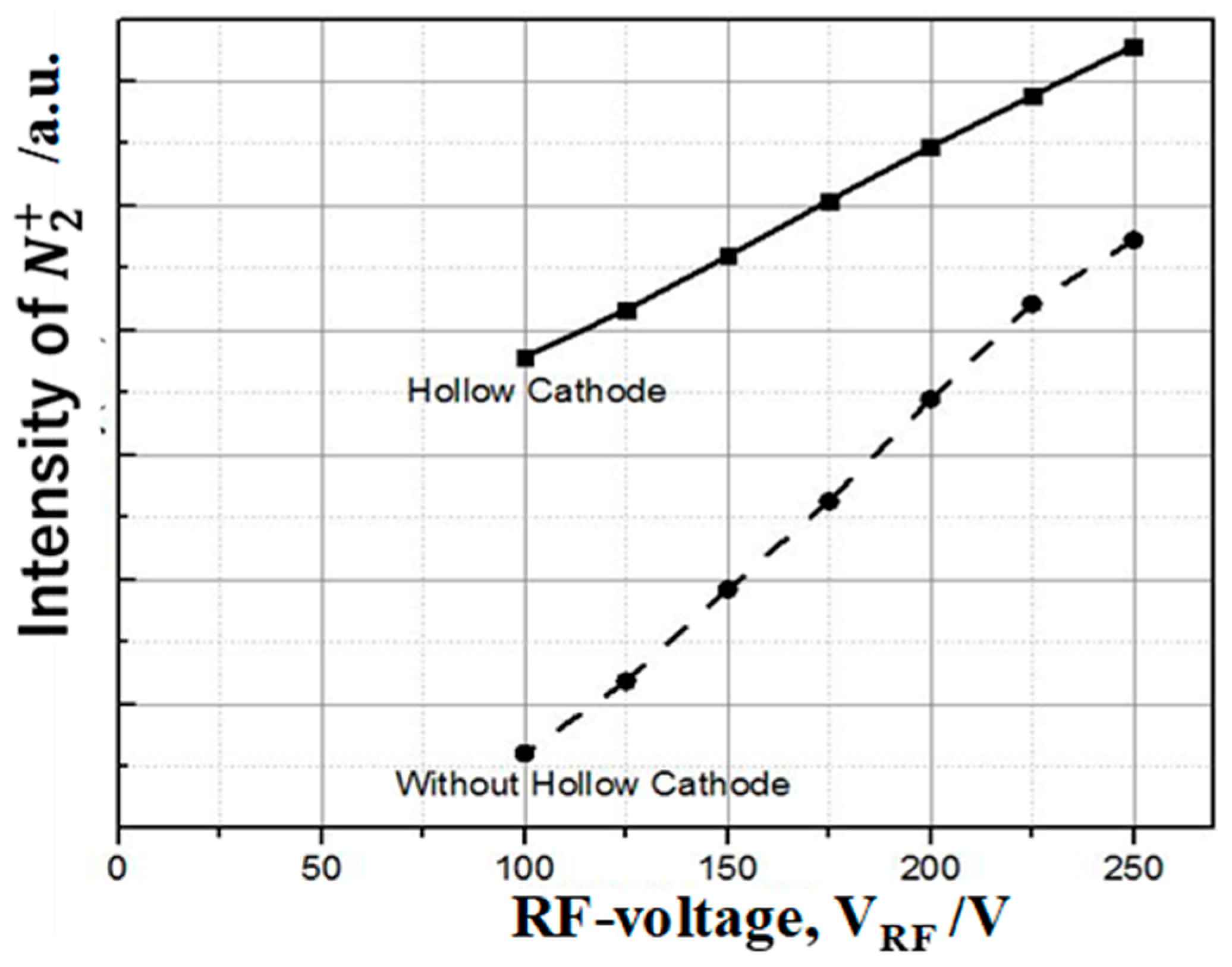
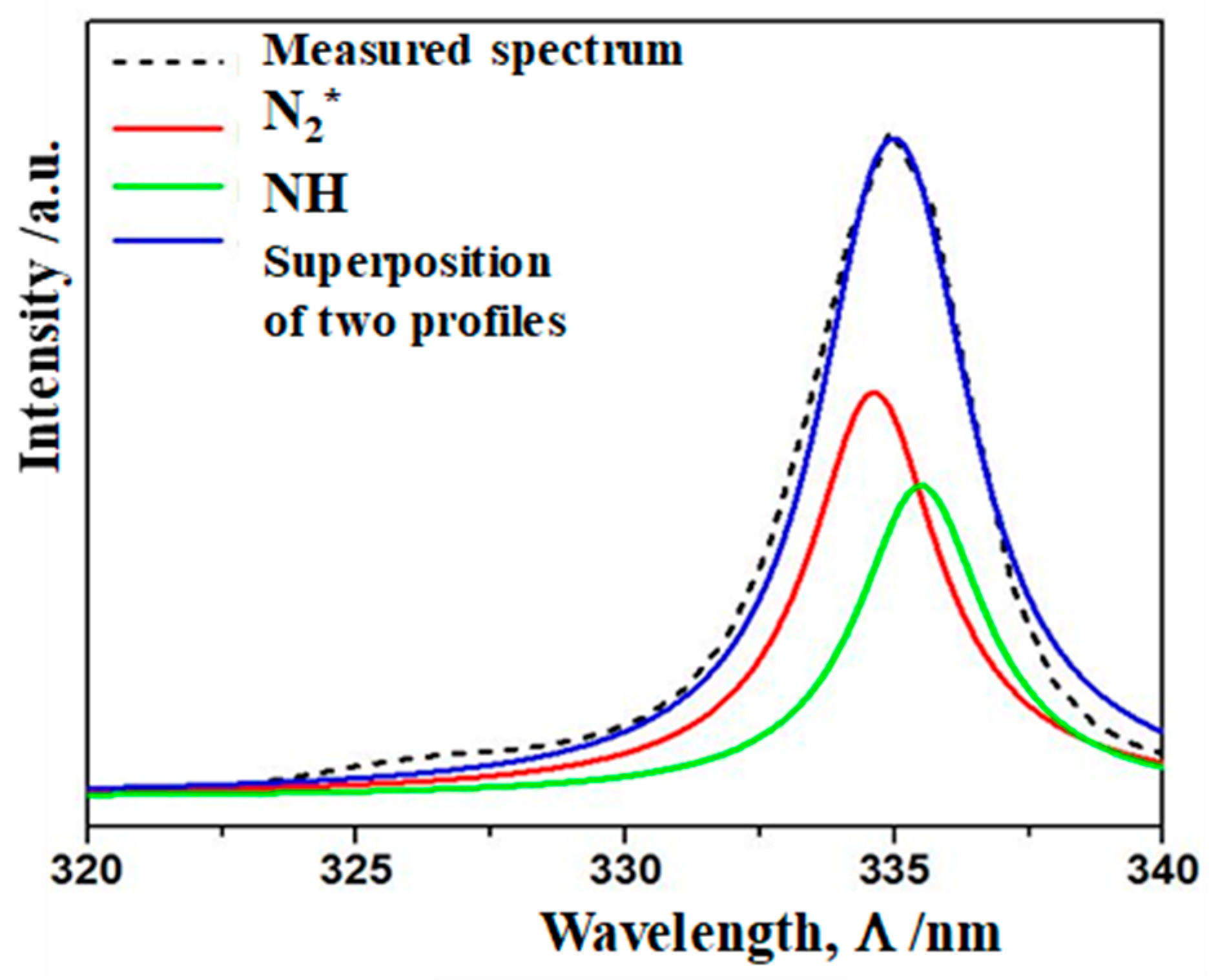

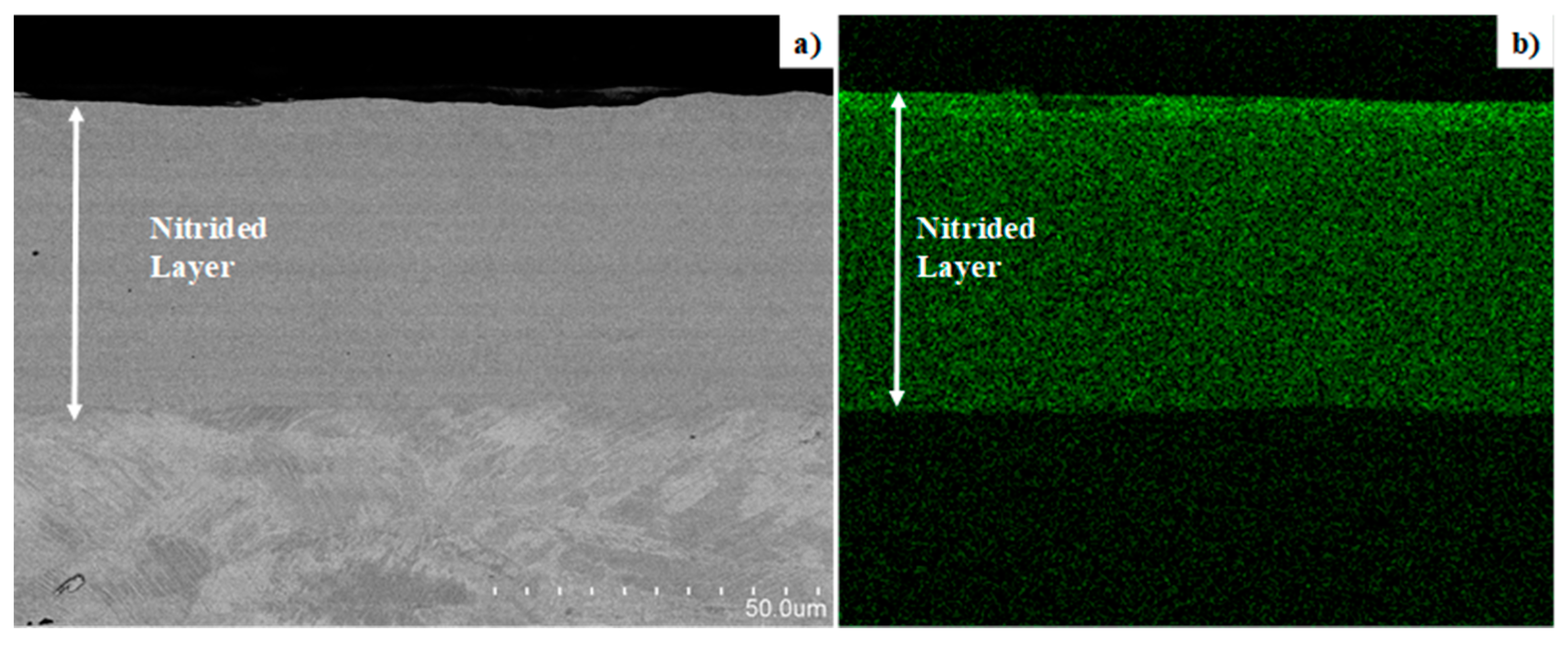

| Species | Transition Array | Peak Position (nm) |
|---|---|---|
| N2* | B3∏g → A3∑U | 580.4 (v′ = 11, v″ = 7) |
| 775.3 (v′ = 2, v″ = 0) | ||
| N2* | C3∏u–B3∏g | 337.1 (v′ = 0, v″ = 0) |
| 380.5 (v′ = 0, v″ = 2) | ||
| 391.4 (v′ = 0, v″ = 0) | ||
| 427.8 (v′ = 0, v″ = 1) | ||
| H | Balmer series | 656.3 (Hα) |
| 486.1 (Hβ) | ||
| NH | Λ-sys a3∏-X3∑− | 336.01 (v′ = 0, v″ = 0) |
| H2 Percentage (%) | Hardness (HV) |
|---|---|
| No treatment | 370 |
| 10 | 760 |
| 25 | 1100 |
| 50 | 680 |
Publisher’s Note: MDPI stays neutral with regard to jurisdictional claims in published maps and institutional affiliations. |
© 2022 by the authors. Licensee MDPI, Basel, Switzerland. This article is an open access article distributed under the terms and conditions of the Creative Commons Attribution (CC BY) license (https://creativecommons.org/licenses/by/4.0/).
Share and Cite
Aizawa, T.; Rsadi, I.; Yunata, E.E. High Density RF-DC Plasma Nitriding under Optimized Conditions by Plasma-Diagnosis. Appl. Sci. 2022, 12, 3706. https://doi.org/10.3390/app12083706
Aizawa T, Rsadi I, Yunata EE. High Density RF-DC Plasma Nitriding under Optimized Conditions by Plasma-Diagnosis. Applied Sciences. 2022; 12(8):3706. https://doi.org/10.3390/app12083706
Chicago/Turabian StyleAizawa, Tatsuhiko, Imron Rsadi, and Ersyzario Edo Yunata. 2022. "High Density RF-DC Plasma Nitriding under Optimized Conditions by Plasma-Diagnosis" Applied Sciences 12, no. 8: 3706. https://doi.org/10.3390/app12083706
APA StyleAizawa, T., Rsadi, I., & Yunata, E. E. (2022). High Density RF-DC Plasma Nitriding under Optimized Conditions by Plasma-Diagnosis. Applied Sciences, 12(8), 3706. https://doi.org/10.3390/app12083706






